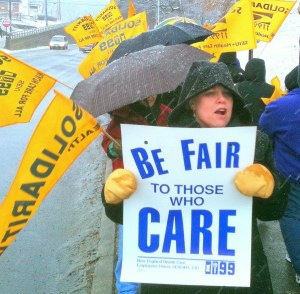Beginning in 2018, Connecticut schools gained a new resource to teach students about the history of the American working class. Centuries of struggle by workers and their unions to build an equitable society have been hidden and distorted at every level of the educational system. This new curriculum plays an important role in correcting that tragic omission.
One of the legislative advocates that created this in the General Assembly was Senator Martin Looney of New Haven. Below are his remarks when the legislation was first introduced.
The link on this page take you to the state Department of Education website with the lesson plans and other materials for teachers (and unions!)
Connecticut Labor and Working Class History
http://bit.ly/TeachingLabor
“In the words of the Czech writer, Milan Kundera, ‘The struggle of man against power is the struggle of memory against forgetting.’ We must teach our children to remember, but they cannot remember if they are not properly taught.

Do they appreciate the historical significance of Eugene V. Debs, Samuel Gompers and John L. Lewis?
Have they learned the history of the Pullman strike, the coal miners’ strike and the Colorado Railroad strike during the early years of the presidency of Theodore Roosevelt?
Have they read about the murder trials of “Big Bill” Haywood and Joe Hill? Do they understand that without labor unions there would be no leisure on weekends or workplace safety and protections that many now take for granted?
Do they realize the inhuman and degrading conditions that the workers of the United States endured before labor successfully organized?
 Have they learned of the revolutionary use of social science in the Brandeis Brief popularized by Supreme Court Justice Louis Brandeis or that the anniversary of this 1908 case with that kind of social science evidence being brought to bear in legal argument was celebrated this past week from that 1908 case? I fear they have not.
Have they learned of the revolutionary use of social science in the Brandeis Brief popularized by Supreme Court Justice Louis Brandeis or that the anniversary of this 1908 case with that kind of social science evidence being brought to bear in legal argument was celebrated this past week from that 1908 case? I fear they have not.
These are but a few of the important historical lessons our children should be taught about the labor movement and the enlightened progress that is championed and helped to realize not only for union members but for the general benefit of society.
There’s also a significant historical role about the documentation of the struggles between labor and the trust in the late 19th and early 20th Century in the work of McClure’s Magazine and the work of outstanding journalists like Ida Tarbell and Lincoln Steffens, Ray Stannard Baker and E.A. White who wrote monumental pieces of investigative reporting during that time. And those words really are a significant part of the history of the time.
 The history of organized labor is so much more than job site action and organizing unions. Unions have pushed state and federal elected officials and judges, as well, to grant workers the right to collective bargaining, where in some cases we see that in the late 19th and 20th Century courts used the issue of impairment of contract to basically say that workers could be barred from organizing, creating the fiction that the low income sole worker had equal bargaining power with the large scale employer by whom he was employed.
The history of organized labor is so much more than job site action and organizing unions. Unions have pushed state and federal elected officials and judges, as well, to grant workers the right to collective bargaining, where in some cases we see that in the late 19th and 20th Century courts used the issue of impairment of contract to basically say that workers could be barred from organizing, creating the fiction that the low income sole worker had equal bargaining power with the large scale employer by whom he was employed.
This struggle taught individual workers that they can achieve success with dignity if they assert their collective power. This right is now being challenged.
Students should know what’s at stake in this challenge. For some, opposition to the teaching of labor history is part of the strategy to marginalize the significant of organized labor as part of a plan to accelerate the decline of union membership especially in the private sector.
Organized labor was a crucial partner in the fight for mine safety laws, workers compensation laws and the passage of the Occupational Safety and Health Act in 1970.
 Labor also fought for the Pregnancy Discrimination Act in 1978, the Americans with Disabilities Act of 1990 and the Family and Medical Leave Act of 1993, among many others.
Labor also fought for the Pregnancy Discrimination Act in 1978, the Americans with Disabilities Act of 1990 and the Family and Medical Leave Act of 1993, among many others.
Currently organized labor is a key supporter of marriage equity. Without the contribution of organized labor, the average worker, even the average non-union worker would have many fewer rights and benefits in employment and we owe it to the children of Connecticut to teach them this extraordinary contribution so that they can remember and win the battle of “memory against forgetting.”
—Testimony by Senator Martin Looney March 12, 2015
